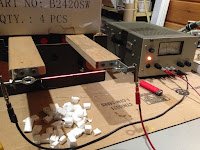I built a simple hot wire foam cutter to make parts for a couple of projects.
I wanted to slit a full sheet of 1.5 inch insulating foam into strips for a mooney wall. Another project, a water heater insulator, required large foam discs.
What started as quick and dirty ended up a very useful tool.
Using scrap wood, I began by adding a slot and a "fence" to a partial sheet of particleboard to make the table. The board was what I had, about 3 foot by six foot supported on two saw horses. I added a strip of wood lengthwise opposite the fence to support the front edge. The table is hung on the wall when not in use. [click any pic to enlarge]
Using particle board was problematic. When fed across the table, large pieces of foam would catch on the tiny sharp fibers sticking out of the particleboard. I later sanded and painted the top surface with several coats of latex paint which helped. It would have been better to use a smoother surfaced board.
The cutter arm is U shaped to support the cutter wire and slides in a groove under the table to adjust. It is then fixed in place for the cut.
I thought to make a variation with the hot wire slide-able to make cross cuts but haven't done that yet.
The slotted hole in the table is for the hot wire. I didn't want to cut through the fence on the back of the table. There is a minimum width that the wire can be set to, about 6 inches and a maximum of about 18 inches. The width of the slots for the mooney wall are 14.5 inches so this is a good amount of adjustment. Varying the dimensions could give other capacities.
The hot wire on the bench with power supply testing cutting action!
It turns out that the wire does not need to be red hot as shown, but just slightly less, sort of a dull red. I have an adjustable DC supply giving the wire about 4 amps at 8 volts. The voltage and current will depend on the wire type, gauge, length and the desired temperature so the adjustable lab supply is a good fit for a hot wire cutter. Normally the supply sits under the table and is connected to the two ends of the hot wire with test leads.
The wire I am using is heater wire (nichrome), typically used in toaster ovens. The first samples of wire I used were harvested from an old appliance. Later I found that I could easily buy small amounts of nichrome wire on Ebay from China so ordered 0.3, 0.4 and 0.5 mm coils.
I found that 0.4mm nichrome gave good cutting life and resistance to breaking. Getting the right temperature and the feed rate requires a bit of experimentation.
Nichrome wire expands when heated, as much as 5%, so there is a spring in the mount to put the wire under tension. When at the operating temperature, there should still be a bit of tension from the spring to get a straight cut.
The wire is simply looped through the eye bolt and wound around itself a few turns. The nuts on the eye bolts are adjusted to put the wire under tension. Normally I form, adjust and test the wire on the bench out in the open, then remove it from the arm, mount the arm on the table and then remount the wire through the slot in the table. It's easier.
Shows the smooth cut on blue type styrofoam. The edge obtained is very smooth.
Cutting foam discs with a pin through the center into the table as a pivot.
Using a thin template to guide the wire to produce a cutout in one of the discs.
Again using a template to make cutouts in one of the discs which has been already cut in half with the wire.
One of the many eight foot by 14.5 inch slabs for the mooney wall that was cut with the wire cutter.
Thanks for your interest.
George Plhak
Lions Head, Ontario, Canada
Detail under the table showing the mount for the arm made from scrap wood. The arm (with the wire removed) is inserted in a slot from the back and fixed in place with the screws that protrude to the right. Crude but adequate.











No comments:
Post a Comment
Your comment will not appear until approved.
I will read your comment and respond to it if I can.
I do not post anonymous comments or links to products that are not relevant.
Thank you. George.